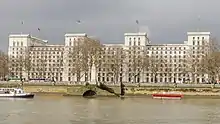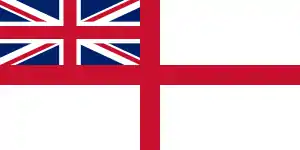Ministry of Defence (United Kingdom)
The Ministry of Defence (MOD or MoD) is the British government department responsible for implementing the defence policy set by Her Majesty's Government, and is the headquarters of the British Armed Forces. It is the UK's ministry of defence.
 | |
| Department overview | |
|---|---|
| Formed | 1 April 1964 (as modern department) |
| Jurisdiction | United Kingdom |
| Headquarters | Main Building, Whitehall, Westminster, London 51°30′14″N 0°07′30″W |
| Employees | |
| Annual budget | £55 billion; FY 2020–21 [3] |
| Minister responsible | |
| Department executives | |
| Child agencies | |
| Website | www |
| This article is part of a series on |
| Politics of the United Kingdom |
|---|
.svg.png.webp) |
|
|
The MOD states that its principal objectives are to defend the United Kingdom of Great Britain and Northern Ireland and its interests and to strengthen international peace and stability.[4] With the collapse of the Soviet Union and the end of the Cold War, the MOD does not foresee any short-term conventional military threat; rather, it has identified weapons of mass destruction, international terrorism, and failed and failing states as the overriding threats to Britain's interests.[5] The MOD also manages day-to-day running of the armed forces, contingency planning and defence procurement.
History
During the 1920s and 1930s, British civil servants and politicians, looking back at the performance of the state during the First World War, concluded that there was a need for greater co-ordination between the three services that made up the armed forces of the United Kingdom—the Royal Navy, the British Army and the Royal Air Force. The formation of a united ministry of defence was rejected by David Lloyd George's coalition government in 1921; but the Chiefs of Staff Committee was formed in 1923, for the purposes of inter-service co-ordination. As rearmament became a concern during the 1930s, Stanley Baldwin created the position of Minister for Co-ordination of Defence. Lord Chatfield held the post until the fall of Neville Chamberlain's government in 1940; his success was limited by his lack of control over the existing Service departments and his limited political influence.
Winston Churchill, on forming his government in 1940, created the office of Minister of Defence to exercise ministerial control over the Chiefs of Staff Committee and to co-ordinate defence matters. The post was held by the Prime Minister of the day until Clement Attlee's government introduced the Ministry of Defence Act of 1946. From 1946, the three posts of Secretary of State for War, First Lord of the Admiralty, and Secretary of State for Air were formally subordinated to the new Minister of Defence, who possessed a seat in the Cabinet. The said three service ministers—Admiralty, War, Air—remained in direct operational control of their respective services, but ceased to attend Cabinet.
From 1946 to 1964, five Departments of State did the work of the modern Ministry of Defence: the Admiralty, the War Office, the Air Ministry, the Ministry of Aviation, and an earlier form of the Ministry of Defence. These departments merged in 1964; the defence functions of the Ministry of Aviation Supply merged into the Ministry of Defence in 1971.[6]
Ministerial team
The Ministers in the Ministry of Defence are as follows:[7][8]
| Minister | Rank | Portfolio |
|---|---|---|
| The Rt Hon. Ben Wallace MP | Secretary of State | Overall responsibility for the department; strategic operations and operational strategy, including as a member of the National Security Council; defence planning, programme and resource allocation; strategic international partnerships: US, France, Germany, Saudi Arabia and the Gulf, NATO; nuclear operations, policy and organisations; strategic communications. |
| Jeremy Quin MP | Minister of State for Defence Procurement | Delivery of the Equipment Plan; nuclear enterprise; defence exports; innovation; defence science and technology including Dstl; information computer technology; the Single Source Regulations Office (SSRO); DIO estates and investment; environment and sustainability |
| The Rt Hon. The Baroness Goldie DL | Minister of State for Defence (unpaid) | Corporate governance including transformation programme; single departmental plan, risk reporting and health, safety and security; EU relations, including Brexit (excluding No Deal planning); engagement with retired senior Defence personnel and wider opinion formers; arms control and counter-proliferation, including strategic export licensing and chemical and biological weapons; UK Hydrographic Office; Statutory Instrument programme; Australia, Asia and Far East defence engagement; Defence Fire and Rescue; safety and security; Scotland, Wales and Northern Ireland devolved authorities; ship wrecks, museums and heritage; Ministry of Defence Police; ministerial correspondence and PQs |
| James Heappey MP | Parliamentary Under-Secretary of State for the Armed Forces | Operations and operational legal policy; Brexit no deal planning; force generation (including exercises); military recruitment and retention policy (regulars and reserves); cyber; Permanent Joint Operating bases; international defence engagement strategy; lead for defence engagement in Africa and Latin America; human security; operational public inquiries, inquests; youth and cadets; commemorations, ceremonial duties, medallic recognition and protocol policy and casework |
| Johnny Mercer MP | Parliamentary Under-Secretary of State for Defence People and Veterans | Civilian and service personnel policy, armed forces pay, pensions and compensation, Armed Forces Covenant, welfare and service families; community engagement, equality, diversity and inclusion, veterans (including resettlement, transition, defence charities and Ministerial Covenant and Veterans Board, and Office of Veteran Affairs), legacy issues and non-operational public inquiries and inquests, mental health, Defence Medical Services
the people programme (Flexible Engagement Strategy, Future Accommodation Model and Enterprise Approach), estates service family accommodation policy and engagement with welfare. Works with Cabinet Office. |
Senior military officials
_General_Sir_Nicholas_Carter_(US_Army_photo_180514-A-IW468-223).jpg.webp)
Chiefs of the Defence Staff
The Chief of the Defence Staff (CDS) is the professional head of the British Armed Forces and the most senior uniformed military adviser to the Secretary of State for Defence and the Prime Minister.
The CDS is supported by the Vice Chief of the Defence Staff (VCDS) who deputises and is responsible for the day-to-day running of the armed services aspect of the MOD through the Central Staff, working closely alongside the Permanent Secretary. They are joined by the professional heads of the three British armed services (Royal Navy, British Army and Royal Air Force) and the Commander of Strategic Command. All personnel sit at OF-9 rank in the NATO rank system.[9]
Together the Chiefs of Staff form the Chiefs of Staff Committee with responsibility for providing advice on operational military matters and the preparation and conduct of military operations.
The current Chiefs of Staff are as follows.[10]
- Chief of the Defence Staff – General Sir Nick Carter
- Vice-Chief of the Defence Staff – Admiral Sir Timothy Fraser
- First Sea Lord and Chief of the Naval Staff – Admiral Tony Radakin (Head of the Royal Navy)
- Chief of the General Staff – General Sir Mark Carleton-Smith (Head of the British Army)
- Chief of the Air Staff – Air Chief Marshal Sir Mike Wigston (Head of the Royal Air Force)
- Commander of Strategic Command – General Sir Patrick Sanders
Other senior military officers
The Chief of Staff is supported by several Deputy Chief of the Defence Staffs and senior officers at OF-8 rank.[9]
- Chief of Defence People – Lieutenant General James Swift
- Deputy Chief of Defence Staff (Military Strategy and Operations) – Lieutenant-General Douglas Chalmers
- Deputy Chief of Defence Staff (Military Capability) – Air Marshal Richard Knighton
- Chief of Joint Operations - Vice-Admiral Sir Ben Key, based at Northwood Headquarters
- Defence Senior Adviser Middle East - Lieutenant-General Sir John Lorimer
Additionally, there are a number of Assistant Chiefs of Defence Staff, including the Defence Services Secretary in the Royal Household of the Sovereign of the United Kingdom, who is also the Assistant Chief of Defence Staff (Personnel).[11]
Senior management
Permanent Secretary and other senior officials The Ministers and Chiefs of the Defence Staff are supported by several civilian, scientific and professional military advisors. The Permanent Under-Secretary of State for Defence (generally known as the Permanent Secretary) is the senior civil servant at the MOD. Their role is to ensure that it operates effectively as a government department and has responsibility for the strategy, performance, reform, organisation and the finances of the MOD.[12] The role works closely with the Chief of the Defence Staff in leading the organisation and supporting Ministers in the conduct of business in the Department across the full range of responsibilities.
- Permanent Under-Secretary of State – Sir Stephen Lovegrove
- Director General Finance – Charlie Pate
- Director General Nuclear – Vanessa Nicholls
- Director General Security Policy - Dominic Wilson
- Director General Strategy and International – Angus Lapsley
- MOD Chief Scientific Adviser Dame Angela McLean
- MOD Chief Scientific Adviser (Nuclear) – Professor Robin Grimes
- Lead Non-Executive Board Member – Lord Grimstone
- Non-Executive Defence Board Member and Chair of the Defence Audit Committee – Simon Henry
- Non-Executive Defence Board Member and Chair of the Defence Equipment and Support Board – Paul Skinner
- Non-Executive Defence Board Member and Chair of the People Committee – Danuta Gray
Defence policy
The Strategic Defence and Security Review 2015 included £178 billion investment in new equipment and capabilities.[13][14] The review set a defence policy with four primary missions for the Armed Forces:[15]
- Defend and contribute to the security and resilience of the UK and Overseas Territories.
- Provide the nuclear deterrent.
- Contribute to improved understanding of the world through strategic intelligence and the global defence network.
- Reinforce international security and the collective capacity of our allies, partners and multilateral institutions.
The review stated the Armed Forces will also contribute to the government's response to crises by being prepared to:[15]
- Support humanitarian assistance and disaster response, and conduct rescue missions.
- Conduct strike operations.
- Conduct operations to restore peace and stability.
- Conduct major combat operations if required, including under NATO Article 5.
Governance and departmental organisation

Governance
Defence is governed and managed by several committees.
- The Defence Council provides the formal legal basis for the conduct of defence in the UK through a range of powers vested in it by statute and Letters Patent. It too is chaired by the Secretary of State, and its members are ministers, the senior officers and senior civilian officials.[16][17]
- The Defence Board is the main MOD corporate board chaired by the Secretary of State oversees the strategic direction and oversight of defence, supported by an Investment Approvals Committee, Audit Committee and People Committee. The board's membership comprises the Secretary of State, the Armed Forces Minister, the Permanent Secretary, the Chief and Vice Chief of the Defence Staff, the Chief of Defence Materiel, Director General Finance and three non-executive board members.[16][18]
- Head Office and Corporate Services (HOCS), which is made up of the Head Office and a range of corporate support functions. It has two joint heads the Chief of the Defence Staff and the Permamant Secretary who are the combined TLB holders for this unit they are responsible for directing the other TLB holders.[19][20]
Departmental organisation
The following organisational groups come under the control of the MOD.[21][22]
Top level budgets
The MOD comprises five top-level budgets. The head of each organisation is personally accountable for the performance and outputs of their particular organisation.
- Navy Command - Royal Navy
- Army Command - British Army
- Air Command - Royal Air Force
- Strategic Command
- Defence Nuclear Organisation
Bespoke trading entity
Executive agencies
- Defence Electronics and Components Agency (DECA)
- Defence Science and Technology Laboratory (Dstl)
- UK Hydrographic Office (UKHO) – also has trading fund status.
- Submarine Delivery Agency (SDA) – created in April 2017 and to be fully functional by April 2018.[23]
Executive non-departmental public bodies
- National Museum of the Royal Navy
- National Army Museum
- Royal Air Force Museum
- Single Source Regulations Office (SSRO)
Advisory non-departmental public bodies
- Advisory Committee on Conscientious Objectors
- Advisory Group on Military Medicine
- Armed Forces Pay Review Body
- Defence Nuclear Safety Committee
- Independent Medical Expert Group
- National Employer Advisory Board
- Nuclear Research Advisory Council
- Scientific Advisory Committee on the Medical Implications of Less-Lethal Weapons
- Veterans Advisory and Pensions Committees
Ad-hoc advisory group
- Central Advisory Committee on Compensation
Other bodies
- Commonwealth War Graves Commission
- Defence Academy of the United Kingdom
- Defence Sixth Form College
- Defence and Security Media Advisory Committee
- Fleet Air Arm Museum
- Independent Monitoring Board for the Military Corrective Training Centre (Colhester)
- Reserve Forces' and Cadets' Associations
- Royal Hospital Chelsea
- Royal Marines Museum
- Royal Navy Submarine Museum
- Service Complaints Ombudsman
- Service Prosecuting Authority
- United Kingdom Reserve Forces Association
Public corporations
Support organisation
In addition, the MOD is responsible for the administration of the Sovereign Base Areas of Akrotiri and Dhekelia in Cyprus.[24]
Property portfolio

The Ministry of Defence is one of the United Kingdom's largest landowners, owning 227,300 hectares of land and foreshore (either freehold or leasehold) at April 2014, which was valued at "about £20 billion". The MOD also has "rights of access" to a further 222,000 hectares. In total, this is about 1.8% of the UK land mass. The total annual cost to support the defence estate is "in excess of £3.3 billion".[25]
The defence estate is divided as training areas & ranges (84.0%), research & development (5.4%), airfields (3.4%), barracks & camps (2.5%), storage & supply depots (1.6%), and other (3.0%).[25] These are largely managed by the Defence Infrastructure Organisation.
Main Building
The headquarters of the MOD are in Whitehall and is known as MOD Main Building. This structure is neoclassical in style and was originally built between 1938 and 1959 to designs by Vincent Harris to house the Air Ministry and the Board of Trade. A major refurbishment of the building was completed under a Private Finance Initiative contract by Skanska in 2004.[26] The northern entrance in Horse Guards Avenue is flanked by two monumental statues, Earth and Water, by Charles Wheeler. Opposite stands the Gurkha Monument, sculpted by Philip Jackson and unveiled in 1997 by Queen Elizabeth II. Within it is the Victoria Cross and George Cross Memorial, and nearby are memorials to the Fleet Air Arm and RAF (to its east, facing the riverside).
Henry VIII's wine cellar at the Palace of Whitehall, built in 1514–1516 for Cardinal Wolsey, is in the basement of Main Building, and is used for entertainment. The entire vaulted brick structure of the cellar was encased in steel and concrete and relocated nine feet to the west and nearly 19 feet (5.8 m) deeper in 1949, when construction was resumed at the site after the Second World War. This was carried out without any significant damage to the structure.[27]
Controversies
Fraud
The most notable fraud conviction has been that of Gordon Foxley, Director of Ammunition Procurement at the Ministry of Defence from 1981 to 1984. Police claimed he received at least £3.5m in total in corrupt payments, such as substantial bribes from overseas arms contractors aiming to influence the allocation of contracts.[28]
Germ and chemical warfare tests
A government report covered by The Guardian newspaper in 2002 indicated that between 1940 and 1979, the Ministry of Defence "turned large parts of the country into a giant laboratory to conduct a series of secret germ warfare tests on the public" and many of these tests "involved releasing potentially dangerous chemicals and micro-organisms over vast swathes of the population without the public being told."[29] The Ministry of Defence claims that these trials were to simulate germ warfare and that the tests were harmless. However, families who have been in the area of many of the tests are experiencing children with birth defects and physical and mental handicaps and many are asking for a public inquiry. The report estimated these tests affected millions of people, including during one period between 1961 and 1968 where "more than a million people along the south coast of England, from Torquay to the New Forest, were exposed to bacteria including e.coli and bacillus globigii, which mimics anthrax." Two scientists commissioned by the Ministry of Defence stated that these trials posed no risk to the public. This was confirmed by Sue Ellison, a representative of the Defence Science and Technology Laboratory at Porton Down who said that the results from these trials "will save lives, should the country or our forces face an attack by chemical and biological weapons."
Territorial Army cuts
In October 2009 the MOD was heavily criticised for withdrawing the bi-annual non-operational training £20m budget for the Territorial Army (TA), ending all non-operational training for 6 months until April 2010. The government eventually backed down and restored the funding. The TA provides a small percentage of the UK's operational troops. Its members train on weekly evenings and monthly weekends, as well as two-week exercises generally annually and occasionally bi-annually for troops doing other courses. The cuts would have meant a significant loss of personnel and would have had adverse effects on recruitment.[30]
Overspending
In 2013 it was found that the Ministry of Defence had overspent on its equipment budget by £6.5bn on orders that could take up to 39 years to fulfil. The Ministry of Defence has been criticised in the past for poor management and financial control.[31] Specific examples of overspending include:
- Eight Boeing Chinook HC3 were ordered in 1995 as dedicated special forces helicopters.[32] The aircraft were to cost £259 million and the forecast in-service date was November 1998.[32] However, although delivered in 2001, the Mk3 could not receive airworthiness certificates as it was not possible to certify the avionics software, and would not enter service until 2017.[33][34] The procurement was described by Edward Leigh, then Chairman of the Public Accounts Committee, as "one of the most incompetent procurements of all time" and the National Audit Office issued a scathing report on the affair, stating that the whole programme was likely to cost £500 million.[35][32]
- In 2010 the Nimrod MRA4 maritime patrol aircraft procurement was cancelled after £3.4 billion had been spent on the programme. In addition there were termination costs which were not disclosed.[36] In January 2011 it was reported by the Financial Times that when the decision was taken to scrap the aircraft, "[it] was still riddled with flaws".[37]
See also
References
- "MOD biannual civilian personnel report: 2018". Retrieved 17 May 2018.
- "UK Armed Forces Quarterly Service Personnel Statistics 1 January 2020" (PDF). p. 4. Retrieved 3 February 2021.
- "Budget 2020". HM Treasury. Retrieved 12 March 2020.
- "The Defence Vision, Ministry of Defence website". Retrieved 3 February 2021.
- Strategic Defence Review 1998 Archived 26 October 2012 at the UK Government Web Archive Ministry of Defence, accessed 8 December 2008.
- Ministry of Defence (10 December 2012). "History of the Ministry of Defence, Ministry of Defence website". Mod.uk. Retrieved 3 June 2013.
- "Her Majesty's Official Opposition". UK Parliament. Retrieved 17 October 2017.
- "Our ministers". GOV.UK. Ministry of Defence. Retrieved 12 May 2015.
- "Organogram - Ministry of Defence". data.gov.uk. 31 March 2016. Archived from the original on 8 August 2017. Retrieved 18 December 2017.
- "Ministry of Defence - Our senior military officials". GOV.UK. Ministry of Defence. Retrieved 23 July 2018.
- "Central Top Level Budget Organogram" (PDF). 8 October 2012. Archived from the original (PDF) on
|archive-url=requires|archive-date=(help). Retrieved 3 February 2021. - "Ministry of Defence - Our management". GOV.UK. Ministry of Defence. Retrieved 18 December 2017.
- "PM pledges £178 billion investment in defence kit". Ministry of Defence. 23 November 2015. p. 27. Retrieved 23 November 2015.
- "UK announces rapid strike forces, more warships in new defence plan". Reuters. 23 November 2015. Archived from the original on 24 November 2015. Retrieved 23 November 2015.
- "National Security Strategy and Strategic Defence and Security Review 2015" (PDF). HM Government. November 2015. pp. 27, 29. Retrieved 23 November 2015.
- "Our governance". GOV.UK. Ministry of Defence. Retrieved 23 August 2015.
- "A Short Guide to the Ministry of Defence" (PDF). nao.org.uk. National Audit Office UK. September 2017. Retrieved 19 September 2018.
- "A Short Guide to the Ministry of Defence" (PDF). nao.org.uk. National Audit Office UK. September 2017. Retrieved 19 September 2018.
- "A Short Guide to the Ministry of Defence" (PDF). nao.org.uk. National Audit Office UK. September 2017. Retrieved 19 September 2018.
- "Head Office and Corporate Services Organogram". data.gov.uk. MOD UK. 30 September 2017. Retrieved 19 September 2018.
- "Departments, agencies and public bodies". GOV.UK. Retrieved 16 December 2017.
- "A Short Guide to the Ministry of Defence" (PDF). National Audit Office. September 2017. p. 40. Retrieved 18 December 2017.
- Baldwin, Harriet (19 July 2017). "Submarine Delivery Body: Staff - Written question 4686". UK Parliament. Retrieved 18 December 2017.
- Overseas Territories: The Ministry of Defence's Contribution (PDF). Ministry of Defence, Directorate-General Security Policy.
- "MOD land holdings bulletin: index". GOV.UK. Ministry of Defence. Retrieved 23 August 2015.
- Better Defence Builds Project Case Study Archived 6 August 2009 at the Wayback Machine
- "The Old War Office Building; a History" (PDF). Retrieved 3 June 2013.
- "House of Commons Debates - Wednesday 16 Oct 1996 - Mr. Mike Hall (Warrington, South)". Hansard. parliament.uk. 16 October 1996. Retrieved 19 January 2008.
- Antony Barnett (21 April 2002). "Millions were in germ war tests". The Guardian. Retrieved 23 August 2015.
- "Cuts force TA to cease training", BBC News, 10 October 2009
- Bowden, David (10 January 2013). "MoD Overspends Equipment Budget By £6.5bn". Sky News.
- "Chinook blunder 'left RAF short'". BBC News. 7 April 2004.
- UK signs deal to get grounded Chinook HC3 helicopters into service By Craig Hoyle 18 October 2007
- Perry, Dominic (29 March 2017). "PICTURES: RAF welcomes updated Chinook HC5". /www.flightglobal.com. Retrieved 27 May 2020.
- Evans, Michael (4 June 2008). "£500m 'wasted' on Chinooks that have never flown". The Times. London.
- "Ministry of Defence: The Major Projects Report 2011" (PDF). www.nao.org. National Audit Office. 16 November 2011. Retrieved 27 May 2020.
- "A failure of UK budget surveillance". Financial Times. 30 January 2011.
Bibliography
- Chester, D. N and Willson, F. M. G. The Organisation of British Central Government 1914–1964: Chapters VI and X (2nd edition). London: George Allen & Unwin, 1968.
External links
| Wikimedia Commons has media related to Ministry of Defence (United Kingdom). |

